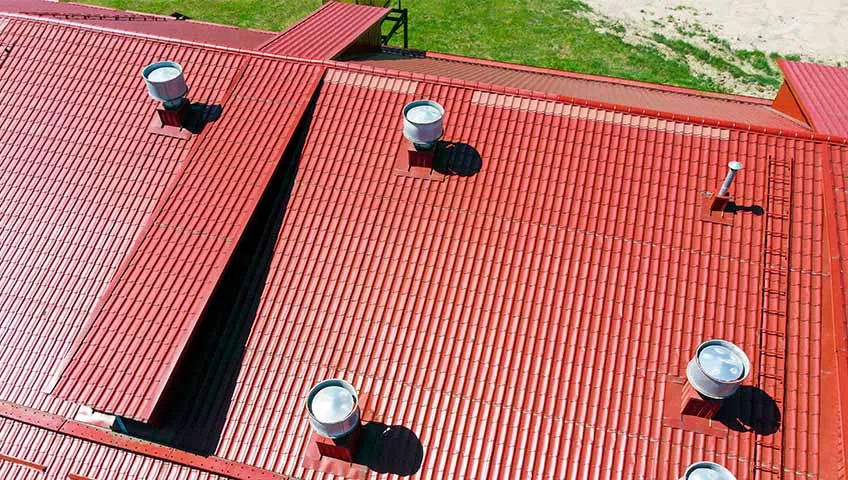Roofing systems protect both residential and commercial properties from weather and other elements. The size and slope of the roof determine the type of materials used. Usually, steep slope roofs are visible from the ground and include architectural tile, asphalt shingles, slate, and metal. On the other hand, flat or slightly sloped roofs are common for commercial buildings. If you are looking for a roofing contractor to install a new roof on your property, you should know the differences between these types of roofing.
Table of Contents
Metal Roofing
Metal roofing is one of the most durable commercial roofing types available such as Commercial Roofing Augusta. Metal roofs can last for more than 60 years with minimal maintenance, and they are resistant to high winds and weather changes. Additionally, metal roofs are extremely energy efficient, and they can reduce cooling costs by 10 to 25 percent. They are often used on office buildings, schools, and other structures that require a durable roof. To learn more about metal roofing, read below!
Metal is not suitable for all locations, however. Seaside commercial buildings are exposed to salt water and will corrode over time. Heavy hail can also dent metal roofs, and debris can compromise their integrity. Alternatively, aluminum roofs offer an environmentally friendly solution. Another type of metal roof is made of steel. These are cheaper than copper but offer the same level of protection and are easy to repair.
Built-up Roofing
Built-up roofing is made from layers of tar and gravel. The number of layers will determine the cost and durability of the roof. It is relatively inexpensive and easy to repair, but its longevity depends on how stable the understructure is. The surfacing layer is also usually coated with a UV-resistant material. This material is durable, but has a short lifespan and can be difficult to spot the source of leaks.
A built-up roof is comprised of several layers of asphalt or tar and is a great choice for low-slope buildings. The gravel layer helps to make it fire-resistant. Built-up roofing is also relatively low-maintenance and requires little maintenance. The multiple layers also prevent water from accumulating in the attic or basement. When applied properly, this roofing type is one of the best for a low-slope roof.
Modified Bitumen Roofing
Modified Bitumen is the most common commercial roofing type. This material provides outstanding durability and tensile strength. It is also waterproof and resistant to tears. It is easy to repair and maintain, and can be patched or replaced easily when necessary. Some types also have a high level of UV resistance. Whether a commercial building is a high-traffic environment or requires increased security, Modified Bitumen roofing is the right choice for you.
Modified Bitumen Roofing is typically installed in single layers, though multiple plies are possible. The bulk of a modified bitumen roof is a membrane, which combines bitumen with reinforcing materials. The more layers a modified bitumen roof has, the better, as each layer can increase its life expectancy. Modified Bitumen roofs require flashing at the edge of the roof, around vents, pipes, and other roof-related interruptions.
Poly Vinyl Chloride (PVC)
If you’re building a commercial building, there are many things to consider when choosing a commercial roof. The structure of the building, the climatic conditions, and foot traffic are all factors to consider when choosing a roofing system. A contractor can offer you a variety of options, including PVC and EPDM. Ultimately, you should choose a material that is suitable for your location, budget, and building’s needs.
PVC is one of the most common commercial roofing types available today. It is composed of two layers of PVC and a polyester reinforcement scrim. The top ply contains additives to make it UV resistant, while the bottom ply is made of plasticizers for flexibility and you can grab it from Commercial Roofing Augusta GA. This type of roofing system is often referred to as thermoset. Moreover, it is easy to repair and requires only a twice-yearly drainage inspection.
Thermoset Roofing
EPDM or Ethylene Propylene Diene Monomer (EPDM) is a roll-based synthetic rubber roofing membrane. It provides excellent resistance to ultraviolet light, is lightweight and easy to install. The material is also UV resistant to most chemicals. The EPDM roof is easy to repair and maintain, with no special maintenance required. The material is a good choice for businesses that are looking to reduce their energy bills and protect their roof from harsh elements.
Concluding Remarks:
One of the main benefits of thermoset roofing is its low maintenance requirements. It is highly resistant to UV rays, ozone, cold temperatures, and even a variety of chemicals, including acid and solvents. Thermoset roof membrane also offers a wide range of benefits, from low maintenance to flexibility. Its reflective properties also help lower energy bills. And because it’s so reflective, it has very low evaporation rates, which helps keep interior spaces cooler.

